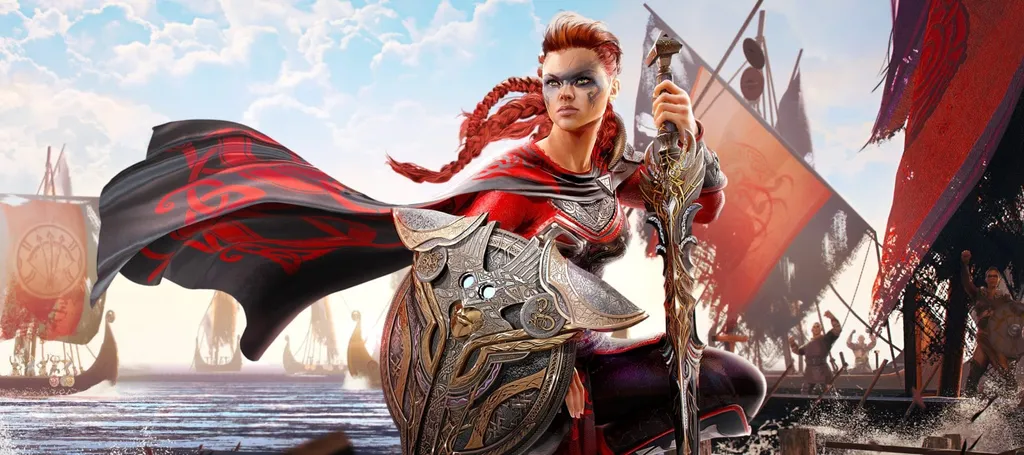The massive action-adventure RPG from Sanzaru Games, Asgard’s Wrath, is finally releasing on October 10th and we’ve spent the better part of the last few days immersing ourselves in the annals of Norse mythology to bring you our full, comprehensive review.
Let me be extremely and immediately clear: Asgard’s Wrath is the best VR game I have played to date. I’ve played a lot of VR games, some of them have better interactions or are designed to be slightly more immersive but no other game that was built from the ground up for VR specifically has ever come remotely this close to capturing the breadth, depth, and creativity of the best AAA video games on the market. Until now.
Watch The Full Video Review:
In Asgard’s Wrath you take on the role of a brand new god in the pantheon of Norse mythology, the God of Animals. Your powers are bestowed upon you by Loki, the Trickster God, as you are tasked with seeking out and aiding a select group of mortal heroes on their personal quests. Once a hero achieves their goal, the manifestation of the virtue they embody (such as Courage or Greed) appears as a stone that Loki needs for a mysterious plot he won’t reveal to you yet.
The vast majority of Asgard’s Wrath takes place in the bodies of the central mortal hero characters. As a god you can possess them and take control of their actions, but you’ll still hear their voices and thoughts. It’s a great mechanic that really takes advantage of the VR premise both conceptually (you’re embodying someone that isn’t you) but also functionally, with the sense of scale. In select areas you can zoom out of the mortal body and look down at the world like a toy box spilled over. These moments are full of small puzzles and collectibles you can find scattered about, but you’ll also have to manipulate the environment to open up passages or clear the path for the hero.
The other key mechanic at the heart of Asgard’s Wrath is your ability to transform animals into humanoid followers. There are nearly a dozen different followers to collect over the course of the campaign each very different from the last. For example, there is a turtle follower with an enormous, thick shell that can block fire for you to pass by safely, but then there’s also an owl follower that can screech at the right pitch to activate tuning forks that magically create bridges. Not only are the followers used for exploration and puzzle solving, but they all have different attacks and uses in combat as well. The shark follower is extremely aggressive for example and can shred through enemy shields when his frenzy is activated, but the eagle follower is a great shot with her bow for ranged support.
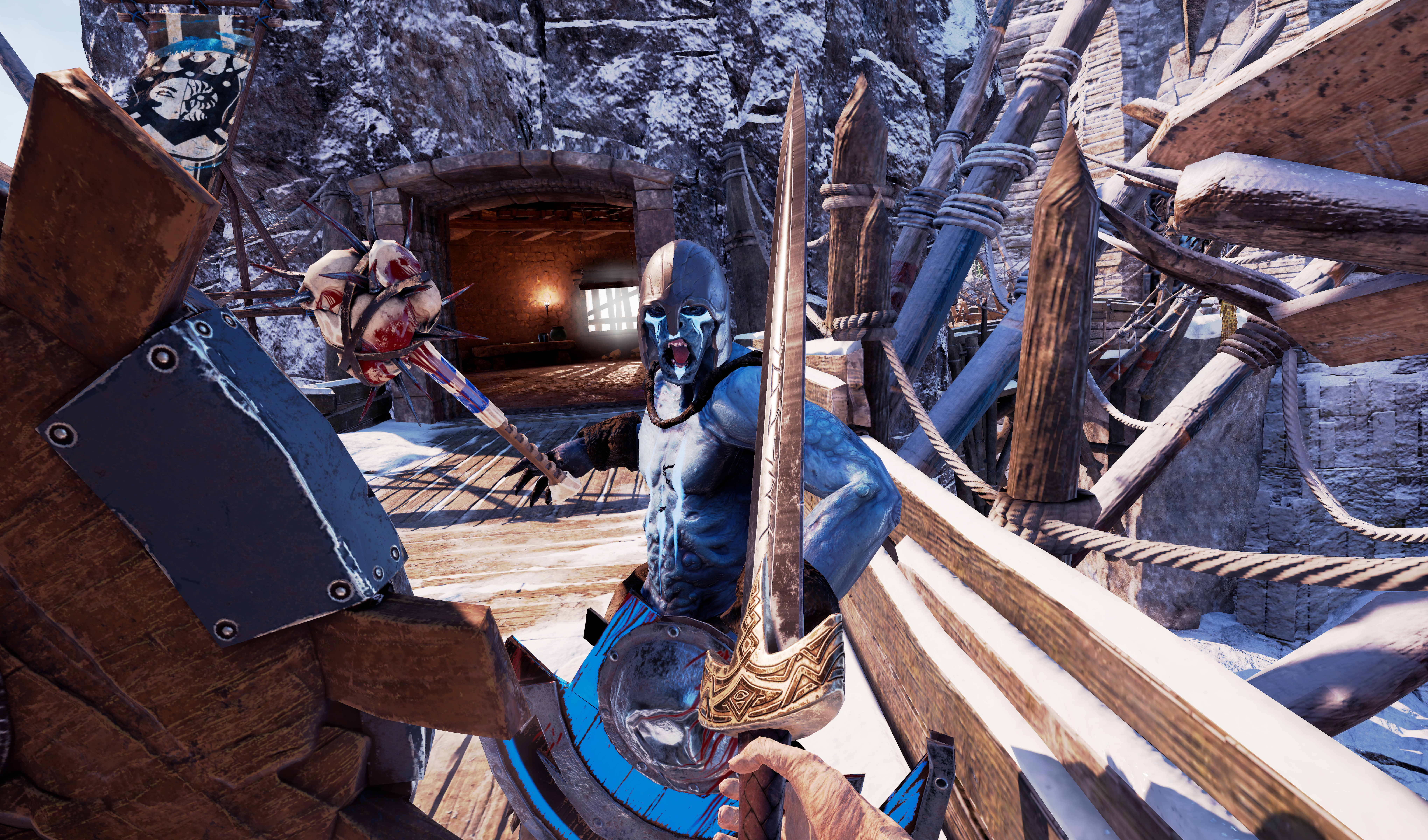
Asgard’s Wrath is split into six different sagas. The first and final saga both take place entirely in your God form as the bookend plot points for the adventure, while the other four each follow a different hero on their personal journey. Ingrid the Shieldmaiden, for example, is prominently featured in most of the art work and imagery for the game but you don’t even have to play as her at all beyond her dedicated story in Saga II. Once you hit Saga III, around the five hour mark in my case, it’s no longer her game. She’s a good mascot, but she isn’t the focus. You are.
There is this great sense of being part of something enormously complex and interwoven in Asgard’s Wrath from the very beginning. If you’re at all familiar with Norse mythology (and I mean actual Norse mythology – while the Marvel universe lifts some characters, ideas and places, it’s generally a far more tame version of actual Norse mythology) then you’ll have some idea of who the key players are here. Familiar names and faces, like Loki, Thor, Hel, Freyja and more, are all portrayed with some excellent voice acting. It would have been nice to get a bit more dedicated exposition and storytelling, rather than just limited conversations before and after Sagas. The musical score is also fantastic, evoking the necessary sense of adventure and epic, grand scale you’d expect.
There is a lot to do and see in Asgard’s Wrath and almost all of it starts and ends with the combat system. If you’ve played Until You Fall, then you’ll have a very good sense of what to expect here. Like that game, it’s extremely focused on parrying enemy attacks. All enemies have health bars (green) that are depleted when they take damage, but some more powerful enemies also have Runic Armor bars (blue) that must be destroyed before standard attacks can damage their health.
For the first half or so of the game, the only way to damage Runic Armor is to parry and block the enemy’s standard attacks, or dodge their super-charged red glowing attacks, to build up their Rage meter (red) below the health bar. Once that’s full, they’ll unleash a Signature Attack, which is denoted by a blue glow. If you parry that, then they’re stunned and you can hit them to take away a Runic Armor bar. It’s got a good flow and works well, but it does start to get a bit repetitive. The downside is that combat is usually extremely reactive and doesn’t incentivize you taking the offensive approach very often until you’re much more powerful with special upgraded gear and items.
Combat in Asgard’s Wrath is sort of a mixture between physics-based and canned animations, but mostly the latter. It’s not like in Blade & Sorcery where the individual weight and velocity of items impacts how they collide via a detailed simulation. However, you do need to react quickly. If an enemy swings downward, you have to tilt your weapon and parry accordingly. If they stab, you’ve got to aim down and thrust towards their trajectory. But when they do attack, recoil or get staggered, it’s the same collection of animations for each enemy type. Upon death, sometimes a ragdoll effect kicks in, which feels silly, and sometimes you’ll chop an enemy in half at the waist but the game thinks you’re slicing vertically and applies the wrong death animation. However, when you’re moving this fast and always looking to the next enemy, you hardly notice that stuff after a few hours.
Eventually, you do get more versatility for dealing with Runic Armor enemies. Some followers deal direct status effect damage like poison and lightning that ticks away health slowly. And others can immediately stagger enemies when in a “Frenzy” state, which is activated by tossing them a Frenzy Potion, and some weapons can even stagger enemies immediately if you charge up a powerful enough attack.
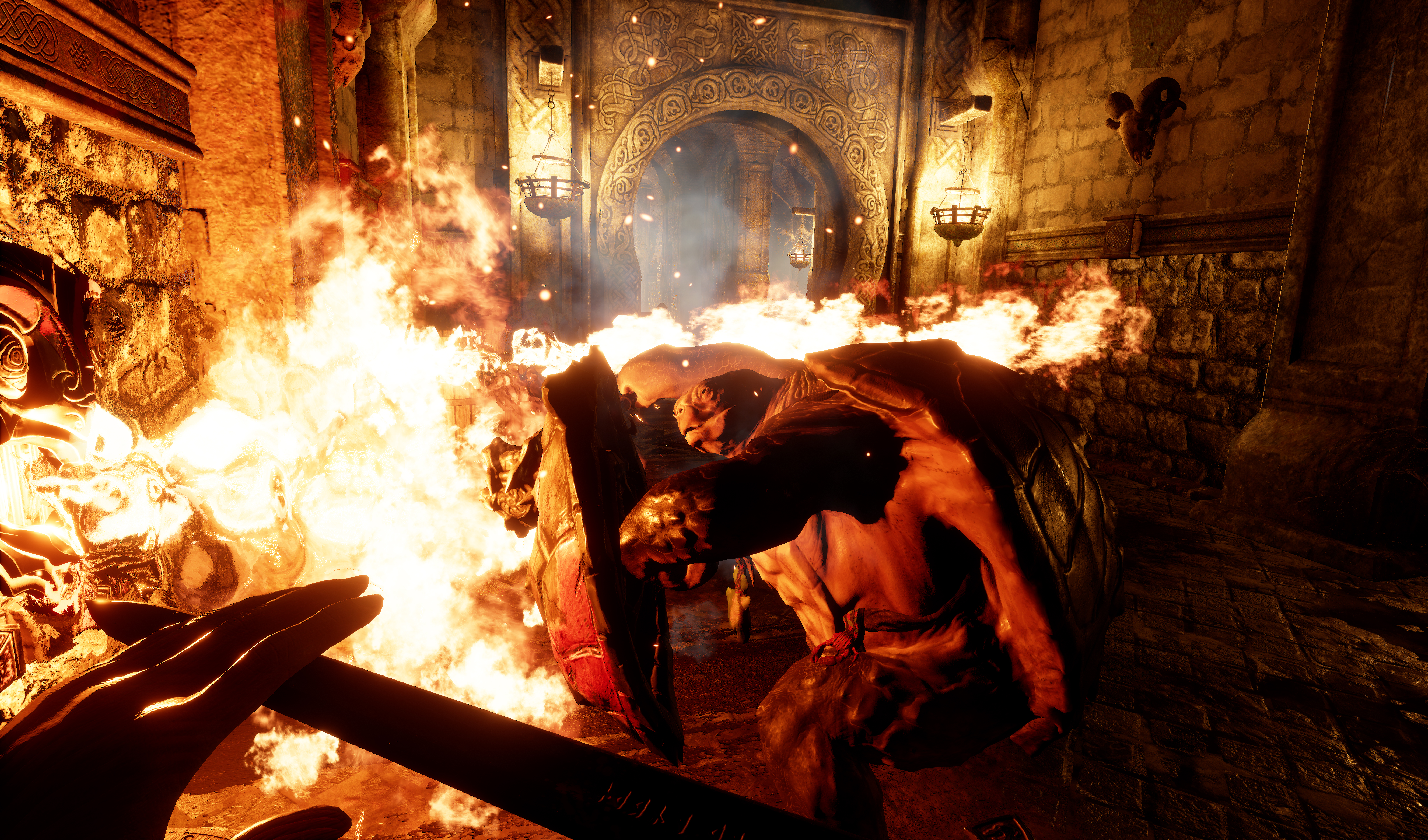
Overall the pacing and progression is balanced well because by the time you start facing multiple Runic Armor enemies at once in groups, you’ll probably have more ways to stagger them on-hand. Many of the biggest encounters in Asgard’s Wrath happen in enclosed arenas that appear in the middle of levels or boss chambers that are often circular, but since these moments are woven organically throughout large, layered and multi-faced zones, it’s not as much of a chore as you’d think.
I’d often go an hour without ever drawing my weapon because of the intricate puzzles and twisting cavers I’m exploring underground. Speaking of which, the puzzles are excellent. As a huge fan of both Darksiders and The Legend of Zelda, I am a sucker for a good dungeon puzzle and Asgard’s Wrath has those in spades. Once you unlock lots of followers, you’ll be switching between them to activate different levers then shooting arrows to hit switches, popping back to another follower for a new beacon, moving blocks around, and more. I did get stumped a few times because the game didn’t communicate some things clearly, but overall the difficulty is very well-balanced.
Watch 20-Minutes of Asgard’s Wrath Gameplay:
The excellent puzzles are a great game mechanic to keep you thinking on your toes and offer a respite from the active, melee-heavy combat, but they’re also a great storytelling device. Other than the main quest there are a litany of side dungeons, side quests, mini challenges and hidden collectibles to find that add to the lore of the heroes and the Gods themselves. Listening to the hero comment on things and make observations, while exploring, and looking at the details of each area has just as much narrative impact as the voice acting and key plot points do.
Moving on from comparisons to Zelda, there is a lot of Metroid and Castelvania at the heart of Asgard’s Wrath as well. This is very much a Metroidvania game, meaning you are encouraged to go back and re-explore areas you’ve been to before using new equipment (or in this case, new heroes and followers) to uncover previously inaccessible passages and items. By returning to one of the first areas of the game after getting more followers, I was able to embark on a 90-minute long side quest dungeon that was full of rich storytelling for Ingrid’s past and it ended with a touching tribute and an excellent new weapon reward.
Watch 14 More Minutes Of Asgard’s Wrath Gameplay:
When Asgard’s Wrath was first announced, it sounded too good to be true. Sanzaru Games and Oculus pitched a game that rivals the scope of most AAA-quality non-VR titles. They were promising over 30 hours of original, non-repetitive content, a vast and highly-detailed world, a fully voice-acted original Norse storyline, and an intense melee-focused combat system. Despite my trepidation and cautious optimism, not only have they absolutely delivered, they’ve exceeded even my loftiest expectations.
Sanzaru Games isn’t completely unfamiliar with this territory. Once upon a time they developed the fourth entry in the fan-favorite Sly Cooper franchise, but since then have relegated their talents to three reasonably polished yet ultimately shallow Oculus-exclusive VR titles in VR Sports Challenge, Ripcoil and Marvel Powers United VR.
[vc_row][vc_column][vc_cta h2=””]Comfort
Asgard’s Wrath has a lot of comfort options to suit many playstyles, but notably, it does not contain a teleportation system at all. This is a smooth locomotion only game. That being said, you can adjust and tweak the movement speed, rotation speed, FOV dimming, snap turning, smooth turning, and more until it feels comfortable. Movement, in general, feels similar to Marvel Powers United VR, Sanzaru’s previous game, and does a good job of accommodating.[/vc_cta][/vc_column][/vc_row][vc_row][vc_column][vc_column_text]
Naturally, you can understand my hesitation with the promised scope of Asgard’s Wrath. But once I realized I had only scratched the surface after finishing the second of five sagas around the five hour mark, and was about to be introduced to the second of five total playable mortal heroes, it started to sink in.
In a world where most VR games are over just as they’re finding their groove, Asgard’s Wrath is a revelation. It took me 25-hours to finally see the credits roll on the main storyline and that required skipping a litany of side quests, ancillary challenges, foregoing a multitude of upgrade options, and focusing almost entirely on just the main story. To see it all I can easily see it lasting upwards of 30-40 hours just as Oculus promised.
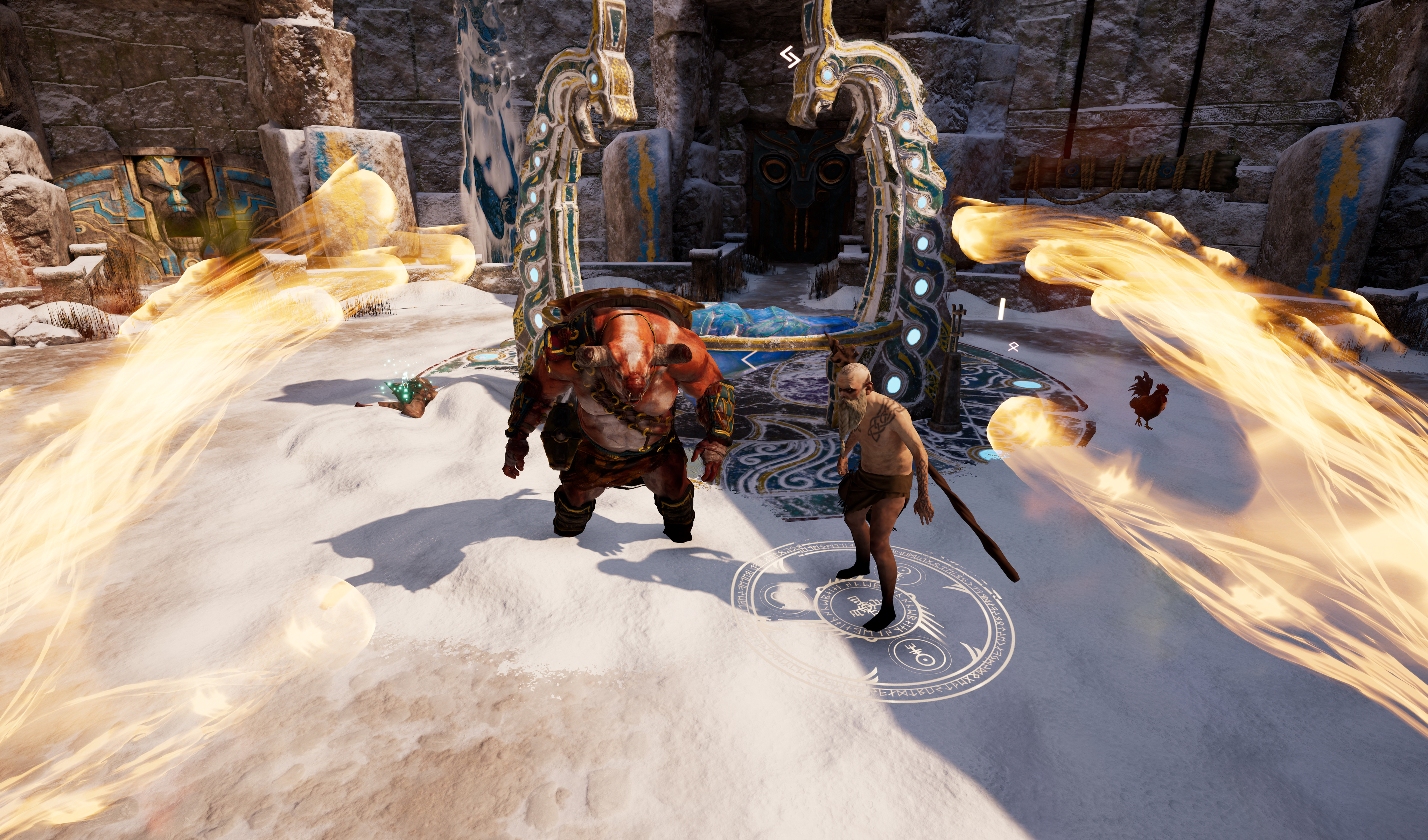
All in all, in this review I have written over 2,000 words and just like my 25+ hour playthrough, it feels like I’ve barely scratched the surface. I didn’t even get a chance to talk about all of the crafting materials you find littered across levels in barrels, boxes, and dead bodies that can be used to upgrade your gear, your followers, and even create items. There are mini games in the tavern hub that revolve around ax throwing and coin bouncing. You can solve gnome riddles to get upgrades for your inventory slots. There’s a mini hero side quest in the tavern that lets you fight off enemies using kitchen utensils. I’ve been to several Norse realms at this point but there is so much untapped storytelling potential for DLC and (hopefully) an eventual franchise.
For example, despite having completed over 75% of the in-game Encyclopedia-style Codex and earning 18 of the 24 achievements in my playthrough, I did end up focusing almost exclusively on the main storyline out of necessity to finish the adventure and only “completed” 36% of the game according to the overall completion percentage. There are also three difficulty settings the lowest of which makes parrying far less necessary, the middle (which I played on) requires it for removing shields, and the highest setting ups the challenge and removes most of the HUD for full immersion.
There is just so much to this game it’s honestly staggering.
Asgard’s Wrath Review Verdict:
Asgard’s Wrath is not only a step forward for Sanzaru Games as a development studio, but also a fundamental advancement for VR games in general. It’s a captivating experience full of enchanting adventure from start to finish. When people buy a headset with the idea of visiting strange, beautiful, and rich new worlds full of exciting things they can only do in VR, this is the type of game they’re imagining. There are some small gripes here and there and it’s not perfect by any means, but it’s certainly the best VR game yet that I’ve played. After over 25 hours of questing through the realms of Norse mythology, all I can think about is the laundry list of things I’ve still yet to discover. Asgard’s Wrath is, from top to bottom, an extraordinary accomplishment.
Final Score: 



 5/5 Stars | Fantastic
5/5 Stars | Fantastic
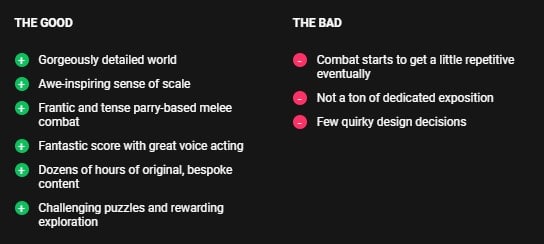
Note: We are changing our review scheme to a five-point scale, without half points, rather than a 10-point scale with half points like before. All past reviews will stay as they are, but all future reviews (that includes games, non-game apps, hardware, and more) will all be reviewed using the same five-point star rating scale. Expect the visual representation of this new scale to change with a more attractive style soon.
You can read more about the new scoring policy here.
Asgard’s Wrath releases exclusively on Oculus Home for the Rift platform on October 10th for $39.99.[/vc_column_text][/vc_column][/vc_row]
Editor’s Note: We updated the review to mention the difficulty settings.

